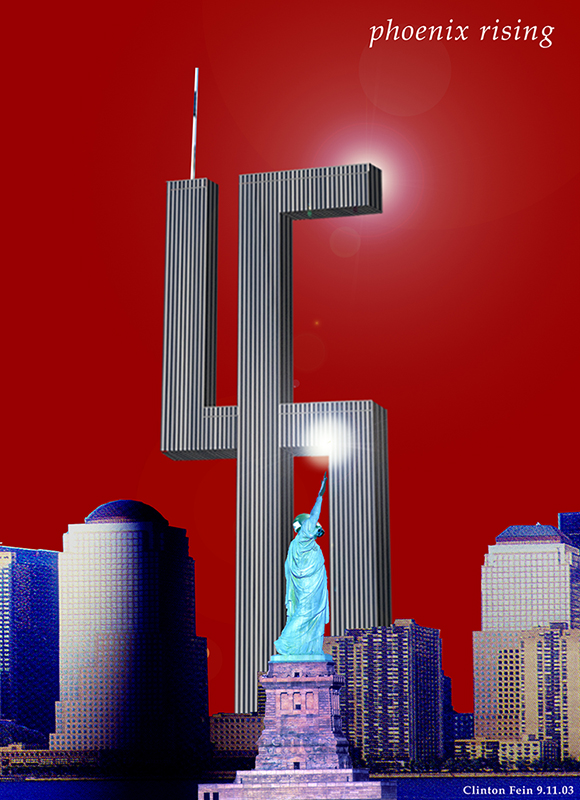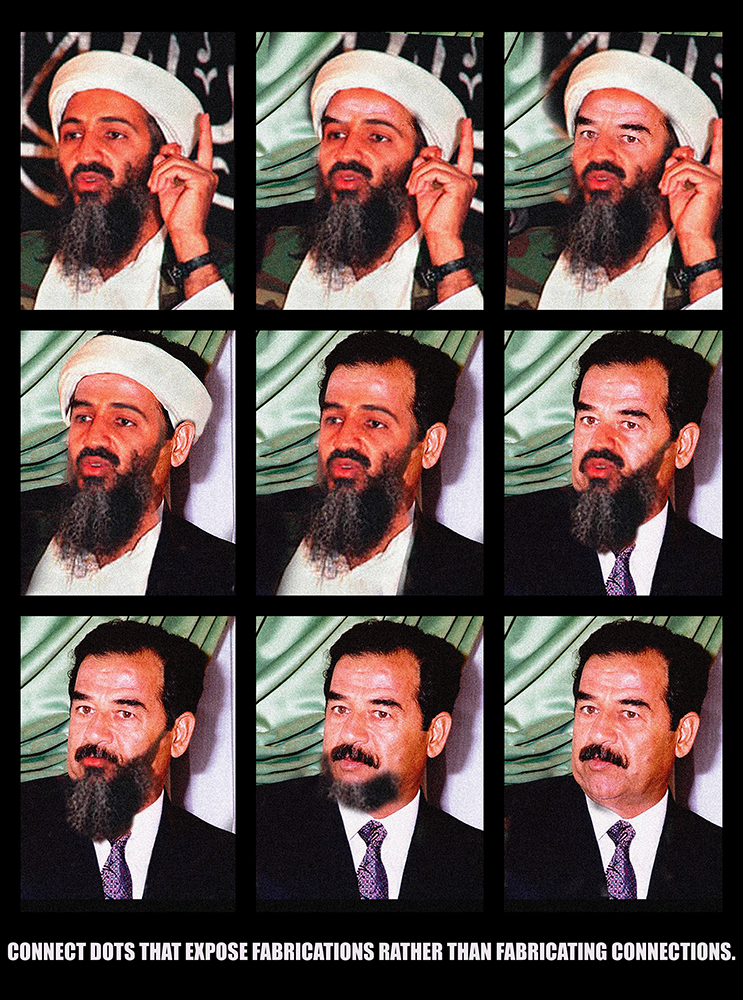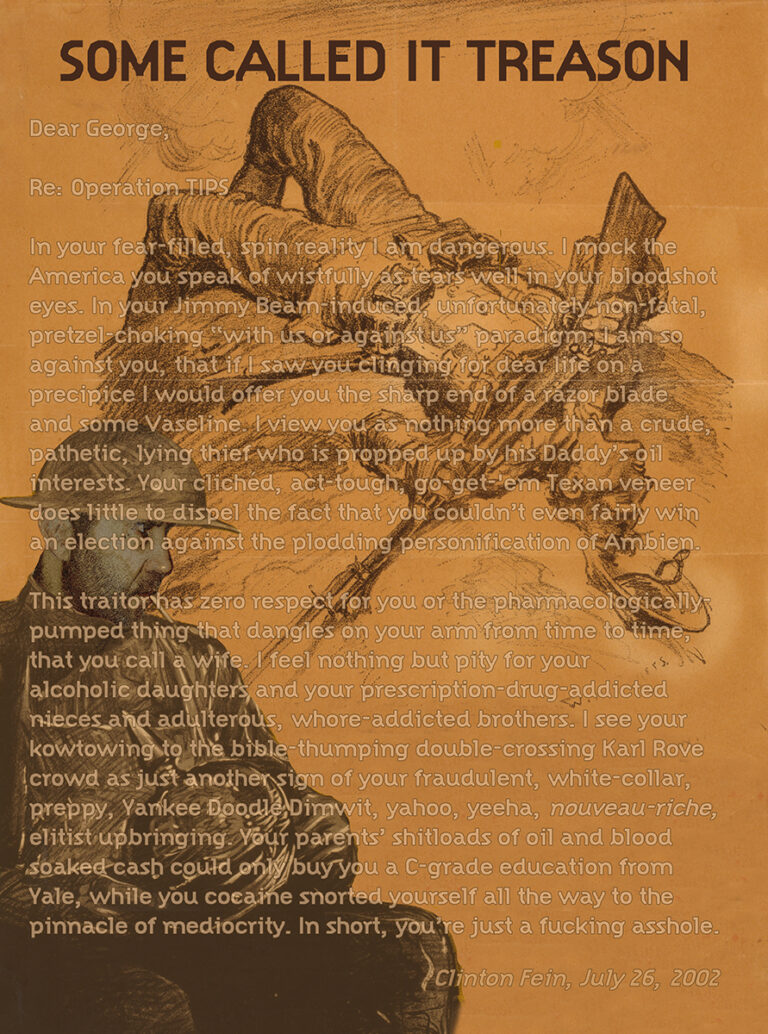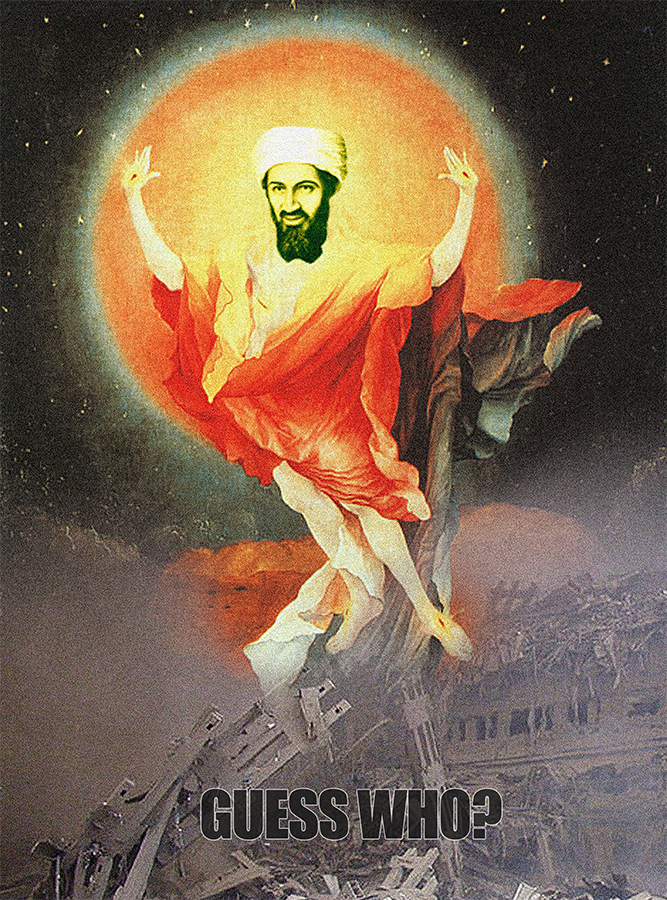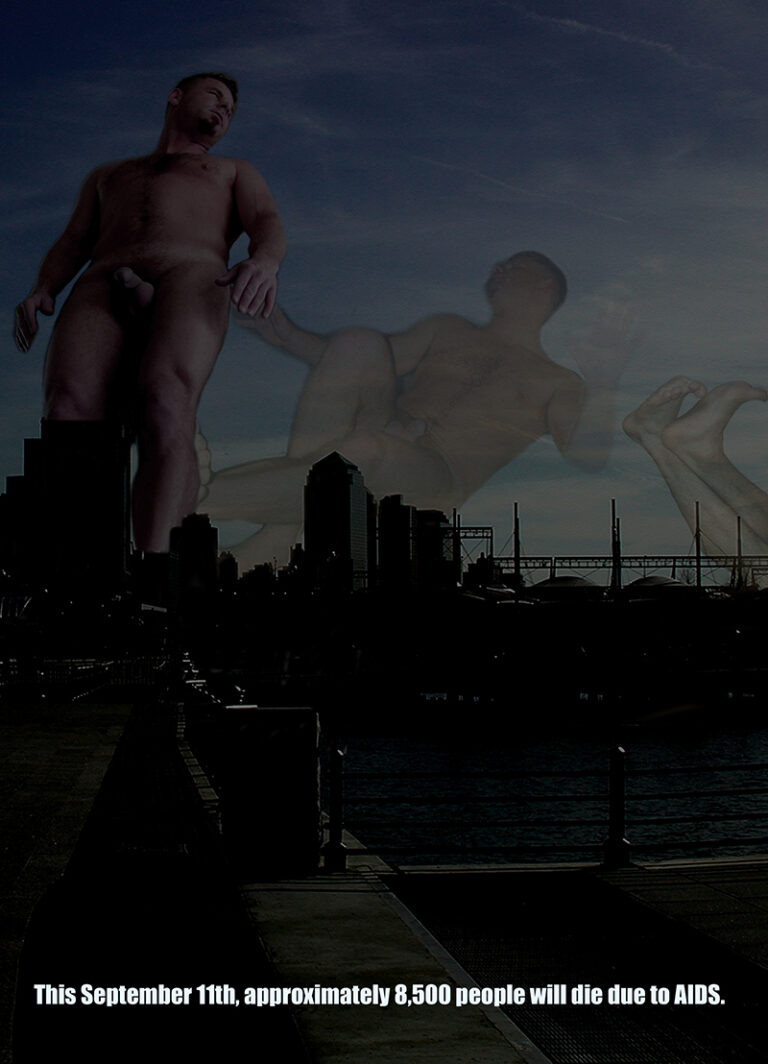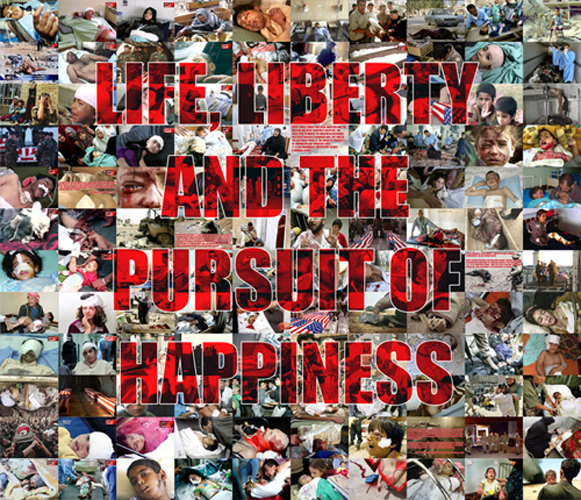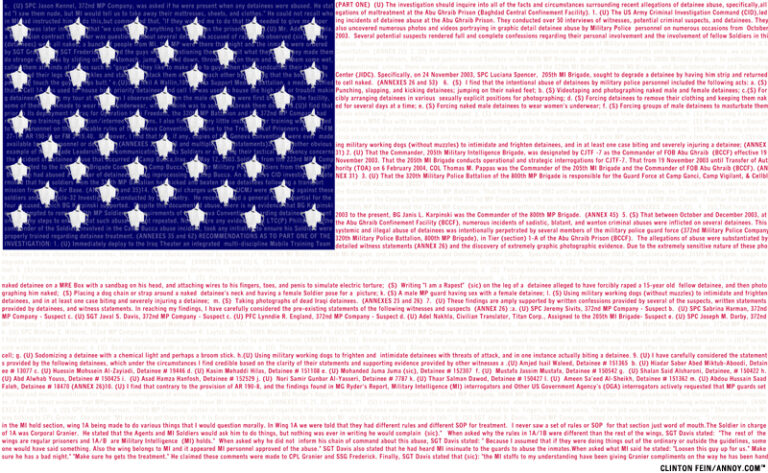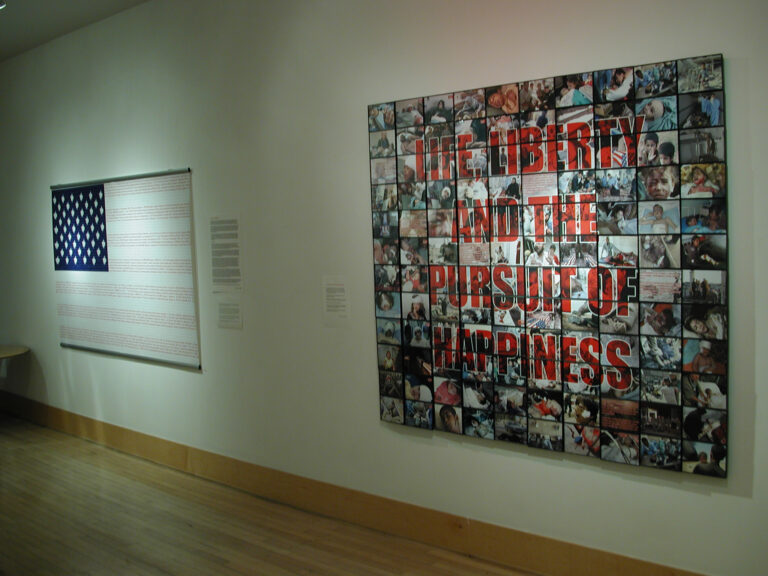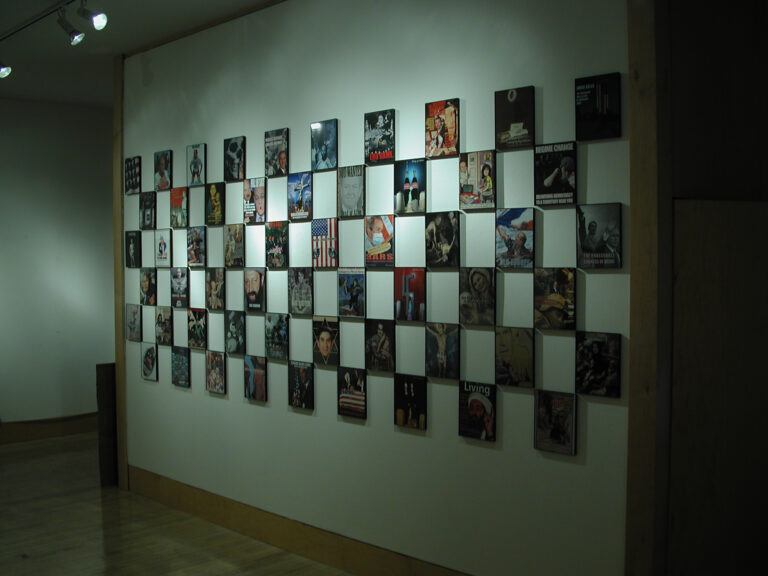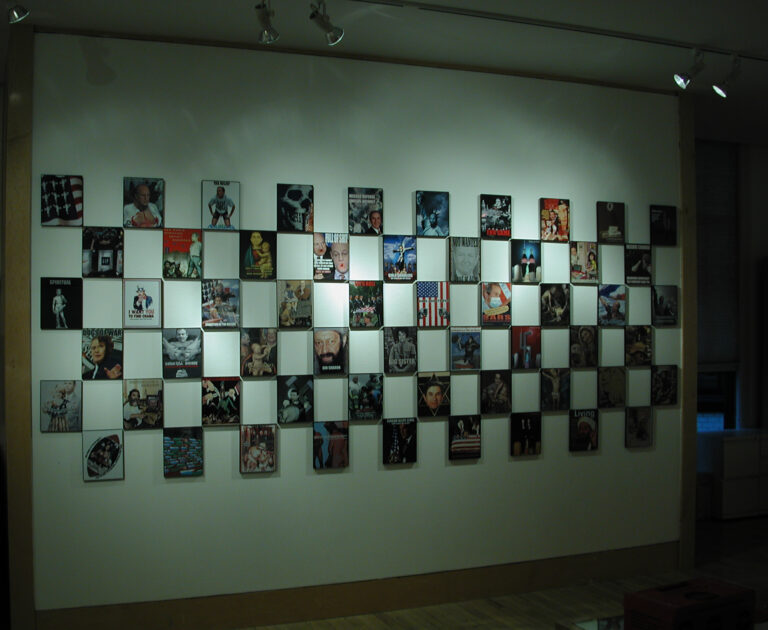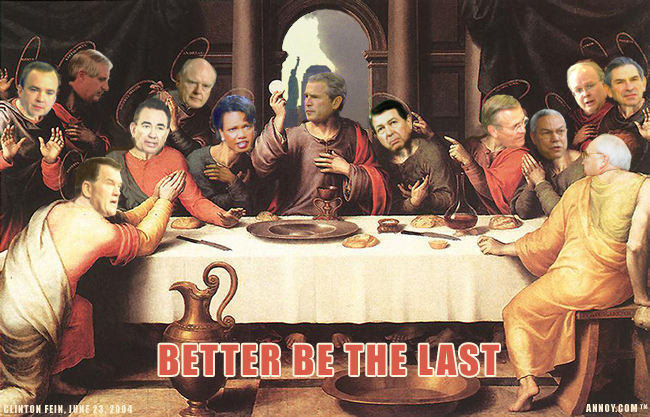
Numb and Number
"This South African provocateur's vitriolic, darkly comic digital montages attack President Bush, his cabinet and his Iraq policies."Numb & Number features digital collages and photo-based work reflecting on the last four years of the Bush Administration. From a misuse of the term fuzzy math that shaped the 2000 election to the daily count of the dead and wounded in the war in Iraq, the show focuses on the extent to which numbers are used to numb, confuse and manipulate an increasingly insecure public. Fein's digital "Weapons of Mass Destruction" are Photoshop, videos, music, poetry, text, photography and imported images off the Internet. Seamless assemblages, photomontages, crude imagery and irony make up a virtual diary of the missteps and calamities of a second Bush regime.
Numb and Number: About the Exhibition
Political artist and Web designer Clinton Fein is most closely identified by his Annoy.com Web site on the Internet. Both alter ego and political forum, the site targets unsavory politicians and their policies — where treachery, deceit, and outright lies are redressed through Fein Justice — meted out through savage satire and searing honesty.
When it comes to the Bush/Iraq debacle, Fein pulls out all the stops. He skewers the current administration with an arsenal of vitriol and shocking humor, utterly eviscerating the powers that be.
 Lewd and ironic postcard images on his Web site highlight the sanctimony and pretense of the administration’s holier-than-thou posture. A satiric re-creation of a Last Supper scenario, for example, features a robed Bush, Cheney and Rumsfeld amid the full panoply of White House power players. The title, Better Be the Last, portends the demise of a bankrupt regime.
Lewd and ironic postcard images on his Web site highlight the sanctimony and pretense of the administration’s holier-than-thou posture. A satiric re-creation of a Last Supper scenario, for example, features a robed Bush, Cheney and Rumsfeld amid the full panoply of White House power players. The title, Better Be the Last, portends the demise of a bankrupt regime.
The burr under Bush’s saddle, Fein is a pesky annoyance who doesn’t go away. His intent to annoy is backed by no less that the U.S. Supreme Court. Knowing too well the effect of censorship in his native South Africa, Fein took on the United States Government in a suit against Attorney General Janet Reno pertaining to the Communications Decency Act. His successful outcome protects vulgar and annoying language on the Internet. Fein’s astute use of the law, as it applies to his artistic ventures, allows him greater latitude to respond creatively to his current political agenda. The confluence of law, politics, art and intellect, as it defines his artistic process, is unusual and unique.
Fein’s latest salvo into the political fray takes the form of two strategically timed, successive solo exhibitions. WARNING!, which opened at New York’s Axis Gallery during the Republican National Convention and runs through October 2, chronicles four years of Bush the Younger as well as a series of deceptively calm photographic installations relating to freedom of expression and vulnerabilities in America’s roads, bridges, trains and ports. Numb and Number, which opens at Toomey Tourell in San Francisco on October 7, focuses on the extent to which numbers are used to numb, confuse and manipulate an increasingly insecure public. Also reiterating on themes of the Bush Administration, the exhibition runs until November 13, comfortably past the Presidential election.
Fein’s digital “Weapons of Mass Destruction” are Photoshop, video, music, poetry, text, photography and imported images off the Internet. Seamless assemblages, photomontages, crude imagery and irony make up a virtual diary of the missteps and calamities of a second Bush administration.
 Fein’s damning riposte to egregious policy hits hard in the instance of Abu Ghraib. Entitled, Like Apple Fucking Pie, the story of this piece takes place in the fine red print of the Taguba report, which the Secretary of Defense failed to read. The artist reworks the text to resemble Old Glory itself. Blank white stripes refer to Rumsfeld’s vacuous response to the torture that took place on his watch. Red stripes are the full accounting of the report, while hooded silhouettes of detainees become white stars set against a blue background.
Fein’s damning riposte to egregious policy hits hard in the instance of Abu Ghraib. Entitled, Like Apple Fucking Pie, the story of this piece takes place in the fine red print of the Taguba report, which the Secretary of Defense failed to read. The artist reworks the text to resemble Old Glory itself. Blank white stripes refer to Rumsfeld’s vacuous response to the torture that took place on his watch. Red stripes are the full accounting of the report, while hooded silhouettes of detainees become white stars set against a blue background.
As a Web-based artist, Fein produces outrageous graphics that make an instant statement. The artist’s deft understanding of his political content and high-impact images are communicated and disseminated globally, taking on an afterlife of their own. His campaign of Shock and Awe is unrelenting as he pairs his message with a meticulous attention to detail. While many slap-dash images circulate on the Internet, Fein makes every pixel count. His aesthetic and technique place him squarely in the historical continuum of political art and graphic design — from Anti-War Cartoons to Propaganda Parodies.
Artists Robbie Conal and the assemblage artists, John Hartfield, are among Fein’s early influences. Research and documentation are the other strategic tools of his trade. Fein’s information must be absolutely accurate in order to keep the pressure on his intended targets. His efforts in this arena are similar in tone to the work of the 1970’s artist, Hans Haacke, who used documentation and photography to successfully unearth corrupt politics and business practices in New York.
In the realm of protest, Fein is an important player in the resurgence of the current anti-war movement. Once neglected, political protest art now flourishes as an effective vehicle of rebellion. Soviet-style and Nazi-era propaganda posters, in their concise graphic intent and message, are effective prototypes for the 21st century. Taped to lampposts or posted on the Web, the content conveyed can be a powerful weapon against prevailing powers.
Fein knew little of the prevailing forces of Apartheid growing up in the suburbs of Johannesburg. During his college years at the University of Witwatersrand, he became increasingly political. In a 1997 interview in The New York Times, Fein recalled the harsh climate of censorship in Johannesburg: “I grew up censored. When I left South Africa, I could be imprisoned for quoting Nelson Mandela. Part of my reason for becoming an American was to enjoy the freedoms of the First Amendment.”
Fein left South Africa for the United States in 1986. Several years later, he had become one of the earliest practitioners of the Internet. The source of his art stems from his highly attuned awareness of injustice. A measured individual, the artist pursues his aims with lawyerly decorum. Fein’s deeper emotions, however, tap into the darker zones of anger and outrage. Indignation is his ally as he brings together a body of work that both appalls and inspires.
The Fein format includes color resolution, pithy slogans and bold fonts infused with ironic intention. The speed and resilience of digital technology make it possible for Fein to create carefully constructed, fully formed graphic images. Researched clips and images — from art history to breaking news — meld into one astonishing image after another. Compositionally, image and text forge strong unassailable pictures.
 In Phoenix Rising, for example, an eerie blood soaked background looms over the gaping absence of the World Trade Center. In its place, the twin towers have been twisted and mangled into the shape of a Swastika. Trading her signature torch for a sieg heil, Lady Liberty oversees the erosion of civil liberties. In the stillness of this image there is a sense of elegiac resignation. It is among the quieter, more somber images in the Fein oeuvre.
In Phoenix Rising, for example, an eerie blood soaked background looms over the gaping absence of the World Trade Center. In its place, the twin towers have been twisted and mangled into the shape of a Swastika. Trading her signature torch for a sieg heil, Lady Liberty oversees the erosion of civil liberties. In the stillness of this image there is a sense of elegiac resignation. It is among the quieter, more somber images in the Fein oeuvre.
Two recent videos from the artist complement his digital work. In Lust for Life, graphic wartime footage showing flesh wounds and maimed children in Iraq is set to fifty-piece plus full orchestral cover of the Iggy Pop song of the same title performed by the Punk Rock Orchestra. Since 1991, the Pentagon has refused to release images of dead or injured victims of war returning to the United States. Using sources from Al Jazeera and other international wire services, Fein has been able to bring to light the horrific toll on the Iraqi people, and juxtapose it against the formal and sanitized return of dead American servicemembers.
One Summer is a video recounting of the antiwar demonstrations on Market Street in San Francisco, 2003. The paraphernalia of resistance and enforcement is played out on streets teeming with protestors as wary police attempt to keep order. Resistors brandish their tools of protest: posters, songs, chants, sit-ins and overall street theater. On the other side of the barricade are officers in the full regalia of police power. Cop jewelry, including clubs, helmets, handcuffs and full-on riot gear, intimates the possibilities of violence as two sides collide. The aesthetics and apotheosis of enforcement is lavishly displayed in the awesome phalanx of police warriors on the line. The Clinton Fein corpus addresses a highly charged, political environment in volatile times. Rooting out complacency through activism is the impetus of Fein’s political engagement. With a hugely important election on the line, the artist urges others to take up his clarion call for action. So much is at stake. His potent images and critical writing make a strong case for advocacy.
Hopefully, Fein justice will prevail.
Deborah Phillips, a longtime editor and reviewer of the visual arts, is currently based in San Francisco.
- 5, 674 former soldiers — mostly people who recently left the service and have up-to-date skills in military policing, engineering, logistics, medicine or transportation — will be assigned to National Guard and Reserve units scheduled to deploy to Iraq or Afghanistan, the Army announced June 2004.
- 784 service members in 2003 alone — more than 37 of them Arab-speaking linguists — were fired for being gay.
- 6 defendants — a “few bad apples” — are deemed responsible for the institutionalized abuse resulting in the Abu Ghraib torture scandal.
- 53 pages of vividly detailed and comprehensively documented investigation conducted by General Antonio Taguba gathered dust at the Pentagon until 1 low-resolution photo of a hooded Iraqi attached to electrical wires destroyed America’s self-imposed moral superiority.
- 1, 032 + American servicemembers have died since the war began, and more than 7,032 have been wounded.
- 12, 778 Iraqi civilians have died since the war began according to a very conservatively estimated minimum by Iraq Body Count, a project which publishes casualty figures derived solely from a comprehensive survey of online media reports.
- 20,000 Iraqi men, between the ages of 15 and 81 have been detained in Iraq since the invasion began, as conservatively estimated by human rights groups at the break of the Abu Ghraib scandal.
- 90 percent of Iraqis detained in American-controlled prisons there were arrested “by mistake” according the Red Cross.
- 100, 000 protestors marched to Madison Square Garden on Sunday August 29th to denounce the Republican National Convention in New York according to the New York Police Department.
- 500, 000 protestors marched to Madison Square Garden on Sunday August 29th to denounce the Republican National Convention in New York according to the organizers of the march.
- 0 “administration officials” have been found accountable for leaking the identity of CIA operative Valerie Plame to Robert Novack and other “media personalities.”
- 1, 000, 000 more viewers tuned into a second broadcasting of Paris Hilton’s “The Simple Life” than an exclusive live interview with President Bush on ABC on which he stated Saddam Hussein should be executed when captured.
- 90, 000, 000 people watched 1 nipple mar the Superbowl.
The ability of the human mind to filter and selectively apply extraneous variables in the formulation of decisions is what constitutes intelligence. The mind’s tolerance of imprecision, uncertainty and partial truth allows it to achieve flexibility, robustness and pliability. This is both a foundation and goal in the design of intelligent technology. The human mind, however, is susceptible to quaint such notions as fatigue, blurry vision, unruly mobs, partisanship, media influence, lies, propaganda and a host of other such external influences that limit effectiveness in its pursuit of speed, precision and accuracy.
It seems the more numbers we are exposed to, the number we get.
Select Media Reviews
One of two digital prints… uses an inflammatory favorite, the American flag, but don’t be fooled by the stripes (texts from the shockingly graphic Abu Ghraib report) or stars (50 profiles of the iconic hooded prisoner on a box dangling electric wires — yikes!). This work has a stunning, subtly nuanced sense of color and composition. Fein’s website, www.annoy.com, is relentlessly anti-Bush and a lot of other things, too. This get-tough attitude, in the “Art of Engagement” tradition, is very West Coast but also has the punch of South Africa, land of Apartheid and diamond mines, where the artist was born and raised. (Artnet)… the irrepressible Clinton Fein (The New York Times)… This South African provocateur’s vitriolic, darkly comic digital montages attack President Bush, his cabinet and his Iraq policies (The New York Times) … The printing service, called Zazzle, informed artist Clinton Fein on Monday that it would not release two of six images for “Numb & Number,” an exhibit of Fein’s deliberately provocative political art (San Jose Mercury News) … Bad-boy political artist Clinton Fein expects trouble and regularly gets it (The San Francisco Chronicle) The company made its decision after determining the prints violated the site’s user agreement on the grounds of being both offensive to religious believers–in this case Christians–and excessively violent (C|NET) .. excessive violence as well as derogatory references to religion (Los Angeles Times) … Clinton Fein’s scalding “Numb & Number” show at the Toomey Tourell Gallery features grim photographs of the war dead and wounded in Iraq … a depiction of Bush as a crucified Christ with a warhead sprouting from his loincloth and a lettered screed on one work about a “crude, pathetic, ugly thief who is propped up by his Daddy’s oil interests.” The leader of the free world, as Fein reviles him with unchecked, ad hominem poison, is in “a Jimmy Beam-induced, unfortunately non-fatal, pretzel-choking, ‘with us or against us’ paradigm. (The San Francisco Chronicle) … Among the rattling images in Fein’s “Numb & Number” show is one of Cheney and Dianne Feinstein’s faces melded together and another of bin Laden as the Statue of Liberty holding Bush’s severed head aloft. (The San Francisco Chronicle) … A current show by another artist-activist, Clinton Fein, called “Numb and Number” at the Toomey-Tourell gallery in San Francisco features digital montages that take off viciously against the current administration. (San Jose Mercury News) … No Mister Nice Guy art at Toomey Tourell, just pure blunt force trauma. Clinton Fein’s imagery may go as far beyond the line as any in expressing sentiments about the current world situation, and about the United States, the War in Iraq, and the Bush administration in particular. If you want to see complete and total venom conveyed through art, see “Numb and Number” and visit Fein’s seditious brainchild, annoy.com. This is the type of stuff that buckets you a first class trip to oblivion in many parts of the world, but not here in America, The Land of the Free (ArtBusiness.com) … Clinton Fein expresses outright scorn at the Bush Administration … His show, entitled “Numb & Number,” is the most potent political art of the year (The Berkeley Camera Club) … California artist Clinton Fein is used to getting flak for his blatantly political and often shocking artworks … ultra-provocative content (ArtsJournal.com) … Home to geek wizards who invented high-resolution imaging technologies that have revolutionized the art scene – home to a digital printing company that has, alas, in this season of partisan fervor, censored two politically-charged art works: that’s Silicon Valley! … why is it censorship if a private business decides not to do business with an artist? Are we not allowed to run our business the way we want to, to work with whom we want to? Or, was this a ploy by Fein to get some publicity for his show … which was launching that same week? (Silicon Valley Watcher) His art is not subtle. It can be hard to take. But Clinton Fein is not afraid to make a statement … Many viewers must wonder whether such low-blow assaults have caused Fein to disown any of his past work… One of the least scabrous but hardest to take pieces in his show lays the words “Life, Liberty and the Pursuit of Happiness” over a grid of photographs from various sources documenting Iraqi war casualties… A lot of Clinton Fein’s political art looks facile, even puerile, to those who see only its inflammatory side, not that he really cares. (The San Francisco Chronicle) … What’s Fein’s sin? Politically confrontational art that aggressively makes use of emotionally charged imagery (Surface magazine)

Portrait of political artist Clinton Fein in his exhibition, for profile in San Francisco at 49 Geary street, 4th floor, Toomey-Tourell Gallery. Event on 10/25/04 in San Francisco, CA. Lea Suzuki / The Chronicle
A lot of Clinton Fein’s political art looks facile, even puerile, to those who see only its inflammatory side, not that he really cares.
People can test their own tolerance for what he does in his show of digital prints, “Numb and Number,” at Toomey Tourell Gallery in San Francisco (through Nov. 13).
“I can’t help doing these things,” Fein, 39, said in a conversation at the gallery. “If I couldn’t express these feelings … I don’t know what. I’d be a very unhappy, knotted, gnarled person … though I don’t always subscribe to the sentiments in the pieces. Sometimes I just do them to put a question out there.”
Consider the image in his show titled “The Unbearable Likeness of Being.” In it, that phrase runs across a black and white image of President Bush waving, with Adolf Hitler behind him, arm upraised in a disagreeably similar salute.
Many viewers will simply take this for a glib and historically irrelevant visual simile.
But those who know the work of John Heartfield (1891-1968), one of Fein’s artist heroes, will catch the unmistakable echo of one of Heartfield’s most famous photomontages, “Millions Stand Behind Me.”
In Heartfield’s original, Hitler stands in the foreground with hand upraised in a half-wave, half-salute, the source picture having been taken at a mass rally.
From behind, a fat cat reaches down to slip a sheaf of banknotes into Hitler’s open hand. Heartfield suggested that the millions behind Hitler that mattered were not people but the backing of German financiers and industrialists.
Fein’s image, similar in design to Heartfield’s down to their common use of black and white, makes a parallel suggestion about Bush’s true constituency.
Fein also adapted his title from Milan Kundera’s 1980 novel “The Unbearable Lightness of Being,” a fictive memoir of Cold War-era Czechoslovakia, thus darkening his implication further with anxiety about America edging toward an Eastern Bloc social condition by its willing surrender of civil liberties since Sept. 11.
A native of South Africa who lives in San Francisco, Fein became an American citizen only 10 years ago. He did it partly to secure the protection of the First Amendment when he produced a CD-ROM of “Conduct Unbecoming,” the expose of gays’ mistreatment by the military that Chronicle reporter Randy Shilts (1951-1994) completed not long before he died of AIDS.
“I figured the U.S. military was going to have issues with what I had done,” Fein said, “so it was best to become an American citizen first. Part of my decision was based on the First Amendment, on the value of what that freedom is.”
But “there have been lawsuits ever since” he began making political art, Fein said.
He has been sued, or threatened with legal action, by the New York Times, the Gap, Ziff Davis and numerous other businesses and individuals whose images, logos or advertising content he has used.
“But I always do a bit of homework before I do a piece,” Fein said. So when the Gap protested a piece he made associating the company with Monica Lewinsky, he had proof at hand that her famous semen-sullied blue dress was a Gap item.
Right now, Fein finds himself in the unusual state of having no legal action pending against him or on his behalf, though he is still considering suing a Palo Alto printer for reneging at the last minute on its contract to produce several incendiary digital prints for his current show.
Fein has prevailed in court before.
“I sued Janet Reno over a provision of the Communications Decency Act,” he said. “It made a felony of transmission over the Internet of any indecent material with the intention to annoy someone.”
For an artist with a Web site called annoy.com devoted to political and other provocations, this was no small matter.
“My questions were, ‘Indecent according to whom?’ and ‘Annoying according to whom?,’ ” Fein said. ” Because you could argue that legislation so badly crafted could be both indecent and annoying.”
Fein dabbled in legal studies while getting a degree in industrial psychology at the University of Witwatersrand in Johannesburg, which Teresa Heinz Kerry also attended. But because it would have qualified him to practice only in South Africa, “there was no point in getting a law degree there, if you intended to leave, as I did,” Fein said.
After living in New York briefly after his graduation, Fein became for several years assistant to the president of Orion Pictures in Hollywood, “a job for which nothing could have prepared me,” he said.
But he had tasted enough of legal theory to live unafraid of litigation. When his case against the U.S. Justice Department reached the Supreme Court, it agreed “in a convoluted and rather tortured ruling … that indecent communications, even if intended to annoy, are and should be protected by the Constitution.”
The government’s framing of its case ironically ended up enhancing constitutional protection of the material he puts on his Web site.
“It will be interesting to see how some of this stuff plays overseas,” Fein said, as he is negotiating gallery shows in Europe and elsewhere.
“Certainly swastika images would be an issue in Germany,” he said, pointing to a piece called “Phoenix Rising,” in which he has redrawn the World Trade Center towers into an architectural swastika.
Another piece that inserts the face of neoconservative war planner Paul Wolfowitz into a Nazi-era anti-Semitic poster could also pose problems.
Many viewers must wonder whether such low-blow assaults have caused Fein to disown any of his past work.
“Not so far,” he said. “I sound a bit like George Bush, saying I’ve never made any mistakes. I’m sure I have. But have I ever regretted a piece? Yeah, maybe, when people completely haven’t got something or have taken the wrong message from it.”
But astonishment at the hypocrisy of politics and popular and media responses to it keep him fired up. So does the sense that the chicanery of power so often betrays the legal and moral promise of the Constitution. “It’s there from the moment you become a citizen” Fein said. “You put your hand on your heart and swear to defend the Constitution — swear before God, which is unconstitutional — to protect the Constitution against enemies foreign and domestic.” He sees himself doing just that in his attacks on the Bush administration’s lethal deceit.
One of the least scabrous but hardest to take pieces in his show lays the words “Life, Liberty and the Pursuit of Happiness” over a grid of photographs from various sources documenting Iraqi war casualties. Each image represents 1, 000 victims, according to credible independent estimates of the Iraq war’s human cost to those it was meant to liberate.
Though “Life, Liberty…” hurts to contemplate, some of Fein’s pieces can spark a smirk irrespective of the viewer’s politics, just by their graphic resourcefulness. The nine panels of “Osama Bin Hussein” (2003) morph the face of Osama bin Laden into that of Saddam Hussein, above the advice to “connect the dots that expose fabrications rather than fabricating connections.” The work just took on new currency with the release of another videotaped message from bin Laden.
“It’s the hypocrisy that find I so distasteful and that inspires venom,” Fein said. “And it’s not just the Bush administration, though they’ve given me lots of fodder. I was equally critical of the Clinton administration and if Kerry wins, I’ve got lots to say about him as well.”
Kenneth Baker
Kenneth Baker has been art critic for the San Francisco Chronicle since 1985. A native of the Boston area, he served as art critic for the Boston Phoenix between 1972 and 1985.
He has contributed on a freelance basis to art magazines internationally and was a contributing editor of Artforum from 1985 through 1992. He continues to review fiction and nonfiction books for The Chronicle, in addition to reporting on all aspects of the visual arts regionally and, on occasion, nationally and internationally.
His art is not subtle. It can be hard to take. But Clinton Fein is not afraid to make a statement
Here in the Bay Area, where artists’ involvement in politics is a venerable tradition, activity this election season has ranged from auctions in the South Bay to more overtly political shows like Enrique Chagoya’s new anti-Bush drawings at the Paule Anglim Gallery in San Francisco and a sculpture at the Yerba Buena Arts Center encouraging people to vote.
And it’s not just here.
In Tempe, the Arizona State University Art Museum caused a stir with its current show of political art, “Democracy in America: Political Satire Then and Now.”
In Portland, an artists’ cooperative created 25,000 paper place mats documenting “corporate and political malfeasance” that it is distributing to roadside diners around the country before Election Day.
Across the country, some of the nation’s most prominent artists — Jasper Johns, Robert Rauschenberg and Richard Serra, to name a few — have been creating limited-edition prints to help a national independent political committee raise money for a get-out-the-vote push.
A current show by another artist-activist, Clinton Fein, called “Numb and Number” at the Toomey-Tourell gallery in San Francisco features digital montages that take off viciously against the current administration. Fein was briefly hobbled when a printing service in Palo Alto objected to some of the images it was printing for him and refused to release them. (Fein was forced to go elsewhere for the printing work.)
South African artist Clinton Fein’s scalding “Numb & Number” show at the Toomey Tourell Gallery features grim photographs of the war dead and wounded in Iraq, a depiction of Bush as a crucified Christ with a warhead sprouting from his loincloth and a lettered screed on one work about a “crude, pathetic, ugly thief who is propped up by his Daddy’s oil interests.” The leader of the free world, as Fein reviles him with unchecked, ad hominem poison, is in “a Jimmy Beam-induced, unfortunately non-fatal, pretzel-choking, ‘with us or against us’ paradigm.”
George W. Bush has never been viewed as a particularly keen supporter of the arts. But in the buildup to the Nov. 2 election, he’s set off a veritable boom in theater, music, visual and conceptual art, dance and stand- up comedy. Countless artists have been galvanized by the current administration’s record and the prospects of a second Bush administration, and they’re not shy about speaking up.
In the teeth of a campaign that both sides are determined to stage manage, audiences are getting one jolt after another of brash, reckless and sometimes subtly incisive art. It may smack of easy target practice, almost all of it aimed from left to right. But there are also forces at work here that collectively animate and enlarge us as the election day denouement approaches. The arts bring the swirling, subconscious currents of politics and passion to the surface.
THE CLINTON CABINET
CLINTON FEIN DOESN’T MIND THE DEATH THREATS IT’S ANOTHER FOUR YEARS FOR BUSH THAT REALLY FREAKS HIM OUT
Artist Clinton Fein is becoming immune to death threats. “Probably the first time I got one, I reacted,” Fein says. “But I decided that the person who’s sending me a death threat is just venting- and if I worry about anyone, it’s the person who isn’t sending me a death threat.”
What’s Fein’s sin?
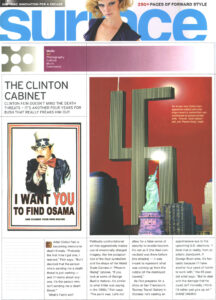 Politically confrontational art that aggressively makes use of emotionally charged imagery, like the juxtaposition of the Nazi symbolism and the shape of the World Trade Centers in “Phoenix Rising” (above). “If you look at some of George Bush’s rhetoric, it’s similar to what Hitler was saying in the 1930s,” Fein says. “The point was: Let’s not allow for a false sense of security to enable fascism. It’s not as if [the Nazi connection] was there before [the attacks]- it was meant to represent what was coming up from the rubble [of the destroyed towers].”
Politically confrontational art that aggressively makes use of emotionally charged imagery, like the juxtaposition of the Nazi symbolism and the shape of the World Trade Centers in “Phoenix Rising” (above). “If you look at some of George Bush’s rhetoric, it’s similar to what Hitler was saying in the 1930s,” Fein says. “The point was: Let’s not allow for a false sense of security to enable fascism. It’s not as if [the Nazi connection] was there before [the attacks]- it was meant to represent what was coming up from the rubble [of the destroyed towers].”
As Fein prepares for a show at San Francisco’s Toomey Tourell Gallery in October, he’s casting an apprehensive eye to the upcoming U.S. elections. “I think that in reality, from an artistic standpoint, if George Bush wins, it’s fantastic because I’ll have another four years of horror to work with,” the 39-year- old artist says. “But to deal with the damage that he could do? Honestly, I think I’d rather just give up art.”
No Mister Nice Guy art at Toomey Turrell, just pure blunt force trauma. Clinton Fein’s imagery may go as far beyond the line as any in expressing sentiments about the current world situation, and about the United States, the War in Iraq, and the Bush administration in particular. If you want to see complete and total venom conveyed through art, see “Numb and Number” and visit Fein’s seditious brainchild, annoy.com. This is the type of stuff that buckets you a first class trip to oblivion in many parts of the world, but not here in America, The Land of the Free. No matter how bad things get, we still have the right to say what we want. And we have this too: VOTE.
Zazzle Loses the Plot
Just before the opening of my Numb and Number exhibition in 2004, Silicon Valley printing company Zazzle characterized the iconic hooded Iraqi with outstretched arms dangling electrical wires, positioned as stars on an American flag as “excessively violent,” in my piece, “Like Apple Fucking Pie.” Before physically destroying it.
The company claimed that the images were inappropriate and might “offend Christians.”
One image depicted an American flag with the stars and stripes made from the text of the official Abu Ghraib report, while the other showed President Bush on a crucifix.
Fein is a prominent First Amendment advocate who successfully fought against the Communications Decency Act.
Zazzle’s decision altered the presentation of the exhibition and damaged the integrity of editions already released by the artist.
Hundreds of art enthusiasts attending the recent opening of South African born artist, Clinton Fein’s, latest exhibition were greeted with a revised exhibition after Palo Alto-based printing company, Zazzle, destroyed two of Fein’s giant images.
Fein learned of the last minute decision after a company representative informed him that two of his images had been deemed inappropriate, and Zazzle did not want to be associated with the images. The abrupt decision by the printing company altered the presentation of the exhibition and damaged the integrity of editions already released by the company.
 The one image, recently reviewed at Chelsea’s Axis Gallery by New York Times’ Ken Johnson, who described it as “an American flag with the stars and stripes made from the text of the official Abu Ghraib report is accompanied by fifty representations of the iconic image of a hooded man teetering on a box with wires trailing from his arms comprising the stars.
The one image, recently reviewed at Chelsea’s Axis Gallery by New York Times’ Ken Johnson, who described it as “an American flag with the stars and stripes made from the text of the official Abu Ghraib report is accompanied by fifty representations of the iconic image of a hooded man teetering on a box with wires trailing from his arms comprising the stars.
The second image depicting President Bush on a crucifix entitled “Who Would Jesus Torture?” was also withheld by the printing company. Company spokesperson, Matt Wilsey, claimed the image might “offend Christians,” and threatened to sue Fein for defamation after Fein warned he would publicly criticize the company’s actions.
Clinton Fein is a prominent First Amendment advocate successfully fought former Attorney General, Janet Reno, in a challenge to the Communications Decency Act (CDA) that was heard before the United States Supreme Court.
“It’s unfortunate that a printing service felt it was more important to apply a bizarre, inconsistently applied standard to an image that nobody ever would have associated with them anyway,” said Clinton Fein. “Particularly since they printed the very image reviewed by The New York Times. When printers begin exercising editorial control over the content they print, standards need to be clear and consistent.”
 The Palo Alto based company publicizes among its associates, ironically, The Hoover Institution on War, Revolution and Peace which defines itself as a “prominent contributor to the world marketplace of ideas defining a free society,” and The Bancroft Library at the University of California, Berkeley.
The Palo Alto based company publicizes among its associates, ironically, The Hoover Institution on War, Revolution and Peace which defines itself as a “prominent contributor to the world marketplace of ideas defining a free society,” and The Bancroft Library at the University of California, Berkeley.
The company claimed Fein’s Abu Ghraib flag represented “excessive violence,” although the image would not have been visible or available through Zazzle. Although Zazzle does hawk a reproduction of a Library of Congress photograph of the hanging hooded bodies of the four conspirators who assassinated Abraham Lincoln, and other violent war imagery, Fein had not granted the company permission to use or display his images, attach their name to his work, nor release any information relating to the content of the work or his relationship with the company.
In subsequent media reports, Wilsey cited a licensee relationship with Disney and acknowledged that the company had first printed the work before they destroyed it. Included in the repertoire of the entertainment conglomerate are films ‘Dogma’ and ‘Priest’, both of which have drawn the ire of Catholics ranging from protests to boycotts. The Walt Disney Company has yet to comment on the destruction of art by its licensees.
“I don’t know what kind of statement such business practices make about academic freedom and thought in a democracy, but when a company associates itself with major brands and institutions it needs to be very careful about the corporate image they present and the consistency of the positions they take,” stated Fein, who is still weighing his legal options. “This is the wrong fight to pick, with the wrong person, at the wrong time. I’d be interested to know exactly how this printer ‘destroys’ art.”
2 of Clinton Fein’s political works run afoul of his printer’s policies
By Kenneth Baker
The San Francisco Chronicle
October 12, 2004
Political artist loses printer over images
By Louise Roug, The Los Angeles Times
October 16, 2004
Print shop refuses to release political images
By Jack Fischer, The San Jose Mercury News
October 6, 2004
Annoy.com Webmaster says war art censored
Paul Festa, C|NET
October 6, 2004
Corporate Policy Leads to Political Censorship
By Molouk Y. Ba-Isa
Arab News
January 11, 2005
Artist and advocate Clinton Fein has his controversial images destroyed prior to exhibition
By Kresta Tyler Johnson
ArtThrob Magazine
November 4, 2004
Printer rebels at artist’s imagery
By Louise Roug
The Los Angeles Times
October 13, 2004
Print shop refuses to release political images
By Jack Fischer
San Jose Mercury News
October 6, 2004
Local Artist Censored: Printing Company Refuses To Release Abu Ghraib Images For Exhibition
Not In Our Name Press Release
October 5, 2004
The Images
Hundreds of art enthusiasts attending the recent opening of South African born artist, Clinton Fein’s, latest exhibition were greeted with a revised exhibition after Palo Alto-based printing company, Zazzle, destroyed two of Fein’s giant images.
The printing company’s abrupt decision altered the exhibition’s presentation and damaged the integrity of editions already released by the company.

